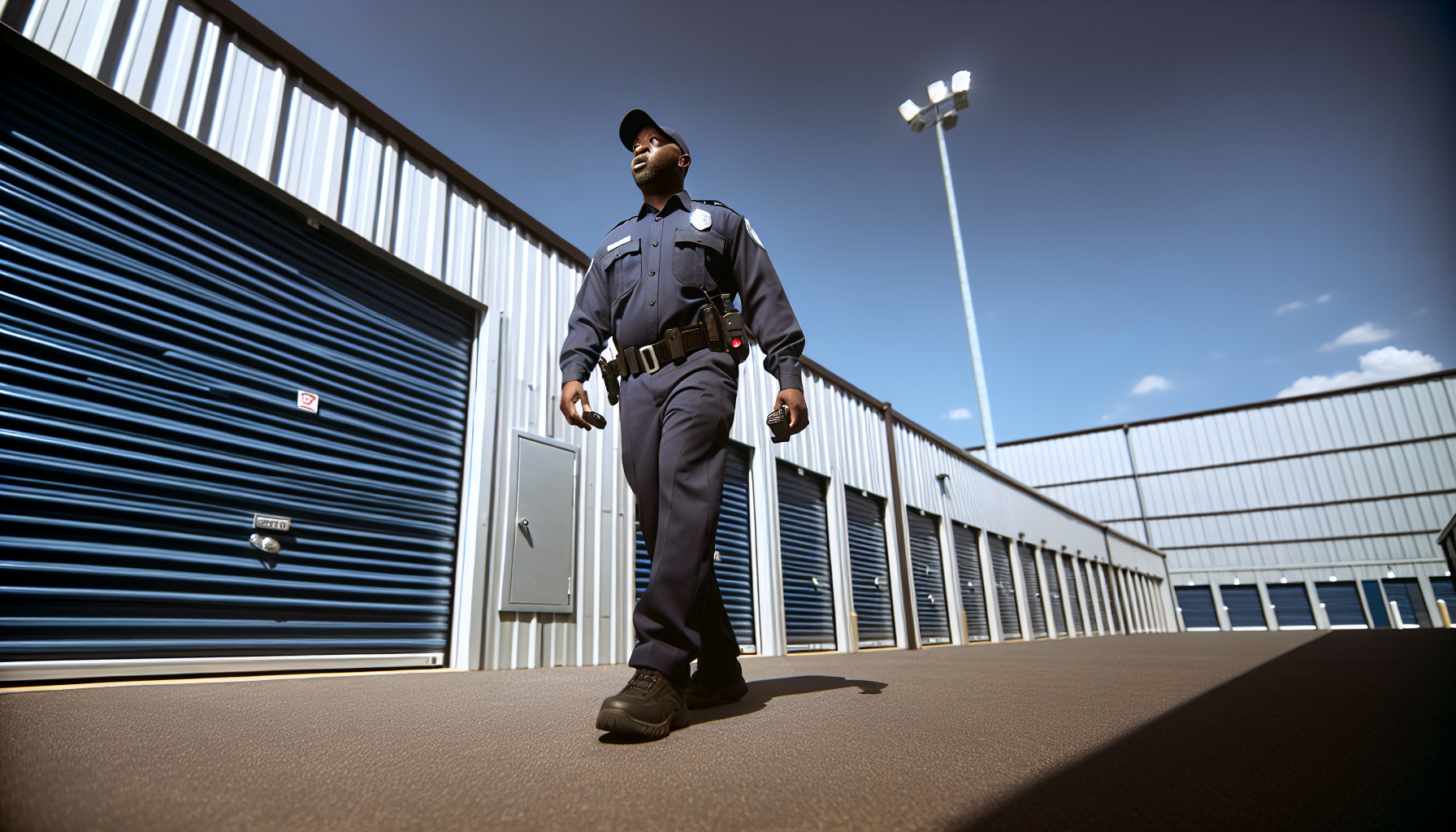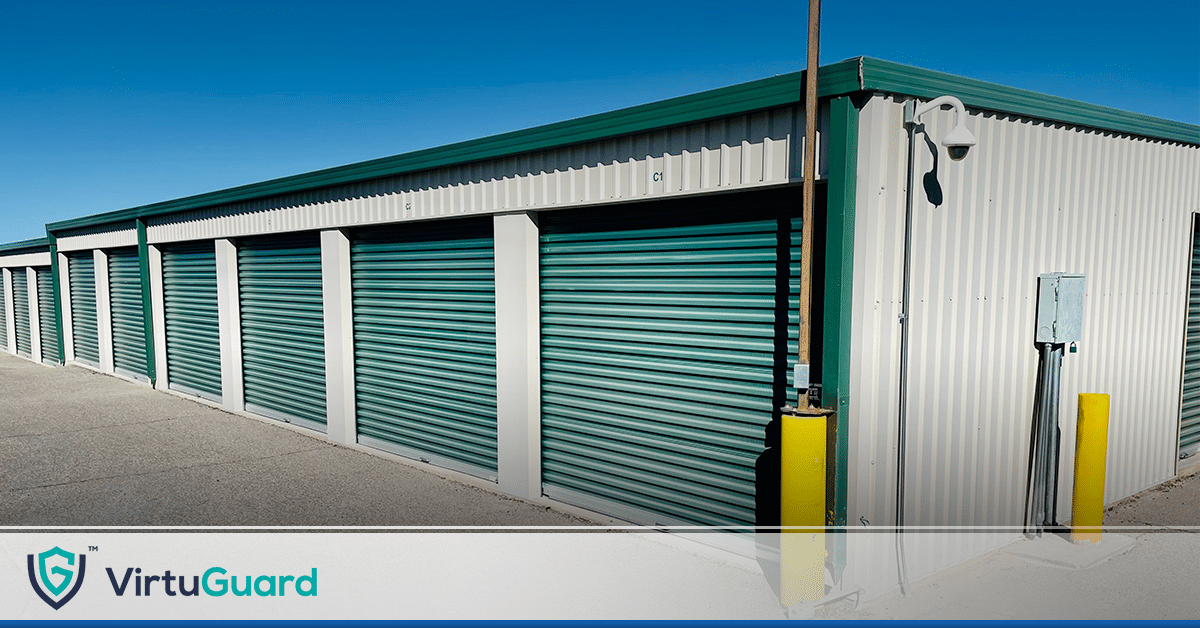Searching for ways to combat crime at self storage facilities? Look no further. This article dives straight into the heart of effective crime prevention strategies, equipping you with the knowledge and tools to not only anticipate potential threats but also to actively deter and respond to them. Expect to gain insights into risk assessment, technology integration, and community involvement – all focused on enhancing the security of your storage property without unnecessary fluff. Start transforming your facility into a safe haven for your tenants today.
Key Takeaways
- Comprehensive understanding of risks, types of crimes, and contributing factors is essential for enhancing security at self-storage facilities.
- A robust security system combining video surveillance, access control, and intrusion detection, complemented by trained security personnel, is critical for crime prevention.
- Ongoing tenant engagement, regular security audits, maintenance, and partnership with law enforcement are key strategies to maintaining and improving facility security.
Understanding the Risks at Self Storage Facilities
To enhance the security of any self-storage facility, one must first comprehend the unique risks they encounter. Various criminal activities are naturally attracted to these facilities, making the understanding of these risks a prerequisite for effective security measures. Factors such as the physical appearance of the storage facility, the actions of tenant, and the responsibilities of the facility manager greatly influence the level of risk associated with the facility.
When it comes to self-storage facilities, an unkempt site with litter, vandalism, and malfunctioning lights might attract criminal behavior, while a well-maintained and secure facility tends to deter it. The role of the facility manager is also significant in crime prevention, as they are responsible for maintaining property cleanliness, performing daily walkthroughs, and ensuring the proper functioning of security devices. Even the behavior of tenants can indicate potential criminal activities, such as lingering around for prolonged periods or attempting unauthorized access to specific areas.
Types of Crimes at Self Storage Facilities
A significant part of enhancing security involves being aware of the types of crimes that occur at self-storage facilities. Common crimes that plague these facilities include theft, vandalism, and illicit actions conducted within rented units. Burglaries often involve unauthorized access gained through lock cutting, while vandalism can be linked to assaults and drug-related incidents.
Additionally, rented units are occasionally used for illegal activities such as drug-related operations, storing stolen items, and conducting illicit business activities. Over the past decade, concerns regarding these crimes have risen, with the increasing reports of break-ins, property crimes, assaults, and violence in both rented and own unit properties. Comprehending these crimes and the methods by which they occur is key to developing effective preventive measures for the entire property.
Factors Contributing to Crime in Self Storage Facilities
A set of specific factors directly influence the incidence of crime in self-storage facilities. Poor property maintenance, for instance, includes failures to properly maintain and repair the facility, resulting in problems like water damage and higher vacancy rates. Such conditions can attract criminal behavior and make the facility a target for unauthorized entry and theft.
Another critical factor is tenant awareness. Vigilant tenants who report suspicious activities and adhere to security protocols can significantly contribute to the safety of the facility. On the contrary, lack of tenant awareness and compliance can amplify the likelihood of criminal behavior, making the facility vulnerable. Thus, it’s important for self-storage facilities to factor these elements into their security planning to establish a safer environment.
Implementing a Comprehensive Security System
After gaining thorough understanding of the risks, the subsequent step involves setting up a robust security system specifically designed to handle these unique challenges. A comprehensive security system for self-storage facilities should include video monitoring, access control, and intrusion detection. These elements work together to deter and detect criminal activity, ensuring the safety and security of the facility.
Video monitoring provides real-time surveillance of the facility, enabling the identification of suspicious activities and individuals. Access control measures ensure that only authorized individuals can enter the premises, restricting potential criminals’ access. Intrusion detection systems alert security personnel to any potential security breaches, allowing for a quick response. Together, these components form a solid defense against criminal activity at self-storage facilities.
Security Cameras and Video Monitoring

The maintenance of security at self-storage facilities relies heavily on security cameras and video monitoring. They provide real-time surveillance, enabling immediate action to be taken when an incident is detected and serving as a strong deterrent to potential criminals. Technological advancements, such as Power over Ethernet (PoE) security camera systems and artificial intelligence, have further enhanced their effectiveness.
These modern security camera systems offer continuous learning and system improvement, high-quality image capture, and the ability to communicate with visitors via a mobile app. Their benefits extend beyond crime prevention. By recording incidents, they help in the investigation process and provide valuable evidence for law enforcement.
Access Control Measures
Access control adds another layer of security in self-storage facilities. Keycards and gate codes are common access control measures that limit facility access to authorized individuals, adding an extra layer of security and reducing the chances of unauthorized access and theft.
Keycards and gate codes work by:
- Allowing only those with the correct code or card to access the facility
- Restricting access
- Enabling the monitoring of entries and exits, making it easier to track tenant activity
- Detecting any unusual patterns that could indicate criminal activity.
Alarm Systems and Intrusion Detection
The addition of alarm systems and intrusion detection sensors further amplifies the level of security at self-storage facilities. They serve as an early warning system, alerting security personnel and law enforcement to potential security breaches. While false alarms may occasionally occur, this prompt alert system allows for quick action, which can prevent theft or other crimes.
There’s a variety of alarm systems suitable for self-storage facilities, including fire alarms, burglar alarms, and perimeter intrusion alarms. Each is tailored to cater to specific security requirements and provides a different type of protection. Intrusion detection systems operate by monitoring for abnormal activity, identifying data inconsistencies, and issuing alerts to facilitate prompt responses to potential security breaches.
The Role of Trained Security Professionals

Despite technology’s significant role in maintaining a secure self-storage facility, the value of human intervention cannot be underestimated. Trained security professionals, whether on-site or remote, play a crucial role in upholding the security of a self-storage facility. They monitor surveillance feeds, respond to alerts, and can communicate with potential intruders, often deterring them from committing any crime.
Security personnel are trained to recognize suspicious activities that an untrained eye might miss. Their presence, even as a virtual guard, adds a layer of security that technology alone cannot provide. They can intervene in real-time, communicate with intruders, and call the local police if necessary, providing an effective and timely response to any security threats.
On-Site Security Guards
The security measures of a self-storage facility heavily rely on the presence of on-site security guards. Their physical presence alone can serve as a deterrent to potential criminals, and their ability to respond quickly to incidents enhances the overall security.
These guards are trained in several areas, including security protocols, crime prevention, and emergency response. Their responsibilities include conducting regular security patrols, monitoring activities, managing entry points, and ensuring the implementation of top-tier access control systems.
Remote Security Monitoring
Remote security monitoring, while different, complements the invaluable services provided by on-site security guards. It provides a cost-effective, continuous surveillance solution that can simultaneously cover multiple locations, ensuring constant safety and security of the property.
Remote security monitoring services use advanced technology to monitor surveillance feeds in real-time. This means they can detect suspicious activities as they happen and respond immediately, often before the potential criminal even has a chance to act.
Encouraging Tenant Participation in Security Efforts
While the roles of security systems and personnel are crucial, the importance of tenant participation in maintaining the security of self-storage facilities cannot be overstated. Tenants are the eyes and ears on the ground. By encouraging them to participate in security efforts, facilities can create a safer environment for all users.
Tenant participation can be encouraged through various methods such as education on security best practices and the establishment of a tenant watch program. By making tenants an active part of the security efforts, facilities can ensure that security is a shared responsibility and not just the duty of the management and security personnel.
Educating Tenants on Security Best Practices
Education stands out as one of the most effective ways to encourage tenant participation in security efforts. By educating tenants on security best practices, facilities can ensure that tenants are well-equipped to protect their belongings and contribute to the overall security of the facility.
Security best practices can include proper unit locking and the reporting of suspicious activities. Tenants can also be informed about the facility’s security measures and their role in maintaining them. This can be done through newsletters, flyers, and workshops, which can help tenants understand their responsibilities and the importance of their role in maintaining security.
Establishing a Tenant Watch Program
Establishing a tenant watch program is another method to encourage tenant participation in security efforts. In such a program, tenants are encouraged to report any suspicious activities or individuals they encounter, contributing to the overall security of the facility.
Creating a tenant watch program involves implementing rigorous tenant-screening practices and effectively communicating the program to tenants. Tenants in such programs are expected to adhere to the facility’s security policies, secure their units, use access methods responsibly, and report any suspicious activities to the management.
Regular Security Audits and Maintenance
The effectiveness of a self-storage facility’s security measures hinges on regular security audits and maintenance. These activities ensure that security measures remain up-to-date and effective in addressing the unique risks posed to the facility.
A comprehensive security audit involves a thorough examination of the storage facility, including property inspection, validation of security system functionality, verification of proper surveillance camera recording, and identification of vulnerabilities or potential issues. It’s also important to focus on areas such as generating reports from management software, ensuring the presence of an effective manager, updating to the latest security components, maintaining a robust rental agreement, ensuring the security of the perimeter fence, and inspecting video surveillance cameras and motion sensors.
Conducting Security Assessments
The role of security assessments is significant in pinpointing areas for improvement and potential vulnerabilities. They involve evaluating the operational and site-specific needs and vulnerabilities of the facility, including factors such as:
- location
- facility size
- access points
- the typical value of stored items
Regular inspections of the facility, including storage units and common areas, are crucial in identifying any potential security issues. These inspections also help uphold the effectiveness of the security measures, ensuring that they continue to address the unique threats faced by the facility.
Upgrading and Maintaining Security Equipment
Similar to how regular assessments are indispensable for identifying potential security issues, the effectiveness of these measures depends on regular maintenance and upgrades of security equipment. Some key steps to ensure the functionality and effectiveness of security equipment include:
- Regularly inspecting cameras and access control systems
- Performing routine maintenance, such as cleaning and testing
- Upgrading equipment as needed to keep up with evolving security threats
By following these steps, you can ensure that your personal protective equipment and security solutions are in optimal condition and providing the necessary protection for your premises.
Regular upgrades ensure that the facility’s security measures remain state-of-the-art, offering the best possible protection. Some ways to enhance the security of a self-storage facility include:
- Installing biometric access control systems
- Implementing surveillance cameras
- Using motion sensors and alarms
- Hiring security personnel
- Conducting regular security audits
Keeping up with the latest advancements in security technology can greatly enhance the security of a self-storage facility.
Partnering with Law Enforcement
Forging a partnership with law enforcement is a critical aspect of maintaining a secure self-storage facility. Having a strong relationship with the local police can greatly enhance a facility’s security measures and deter potential criminals.
Some ways that facilities can foster a strong partnership with law enforcement include:
- Inviting officers to use the facility for training
- Offering rental discounts to law enforcement personnel
- Requesting to be included on the local department’s routine drive-by list
This partnership not only enhances security but also helps build a sense of trust between the facility operators and law enforcement agencies, contributing to a more secure network.
Sharing Information with Police
By sharing information about incidents and trends with the police, law enforcement can gain a better understanding of crime in the area and address it more effectively. However, it’s important to note that self-storage facilities are obligated to furnish information and grant access to their premises to law enforcement agencies solely upon receipt of a valid subpoena or search warrant.
Sharing incident reports with law enforcement:
- Ensures that they are kept informed about the activities and incidents at the self-storage facility
- Allows for a more efficient response to criminal activity
- Aids law enforcement efforts
- Contributes to the overall safety and security of the community.
Inviting Law Enforcement Presence
The presence of law enforcement at the facility can serve as a formidable deterrent to criminals. Routine police patrols can discourage potential criminals and establish a noticeable presence of law enforcement. In addition, offering facilities for local departments to train their K9 officers can discourage criminals from using their units for drug storage.
Moreover, cultivating a positive relationship with local law enforcement can contribute significantly to prevent crime. Strong ties with law enforcement encourage better communication, increase the likelihood of crime prevention, and ensure smooth handling of legal processes such as obtaining subpoenas.
Summary
In summary, maintaining a secure self-storage facility involves a multi-faceted approach that includes understanding the unique risks, implementing a comprehensive security system, encouraging tenant participation, conducting regular security audits, and partnering with law enforcement. Each of these elements plays a crucial role in deterring crime and ensuring the safety of both the facility and its users.
Security at self-storage facilities is not a one-time task but a continuous process that requires constant vigilance, regular maintenance, and improvements. By following the strategies outlined in this guide, operators can significantly enhance the security of their facilities, providing a safe and secure environment for their tenants.
Frequently Asked Questions
How safe is self storage?
Self storage safety varies depending on the facility. Units with good security measures are safe from break-ins, while well-maintained facilities with climate-controlled units can protect belongings from rain damage, mold, and theft. Personal precautions can further enhance the safety of stored items.
What are most overlooked self storage risks?
The most overlooked self storage risks are theft, fire, break-ins, hidden costs, inadequate surveillance, and environmental risks. It’s important to avoid storing important documents, jewelry, documents with personal information, money, and valuable items in a storage unit.
How do I protect my belongings in a storage unit?
To protect your belongings in a storage unit, choose the right storage facility, use sturdy packing boxes and containers, and ensure sole access to your storage container for added security. Safe transportation in and out of storage is also important. Avoid storing fragile items directly on the floor.
Can I sleep in a storage container?
Sleeping in a storage container is generally discouraged and unsafe, as well as against the rules of many storage facilities due to security concerns. It’s best to find a safer and more appropriate place to sleep.
What is a virtual security?
Virtual security is a system where trained staff can remotely observe and interact with security solutions to enhance protection. It is also known as security virtualization and is software-based to operate within a virtualized IT environment.
